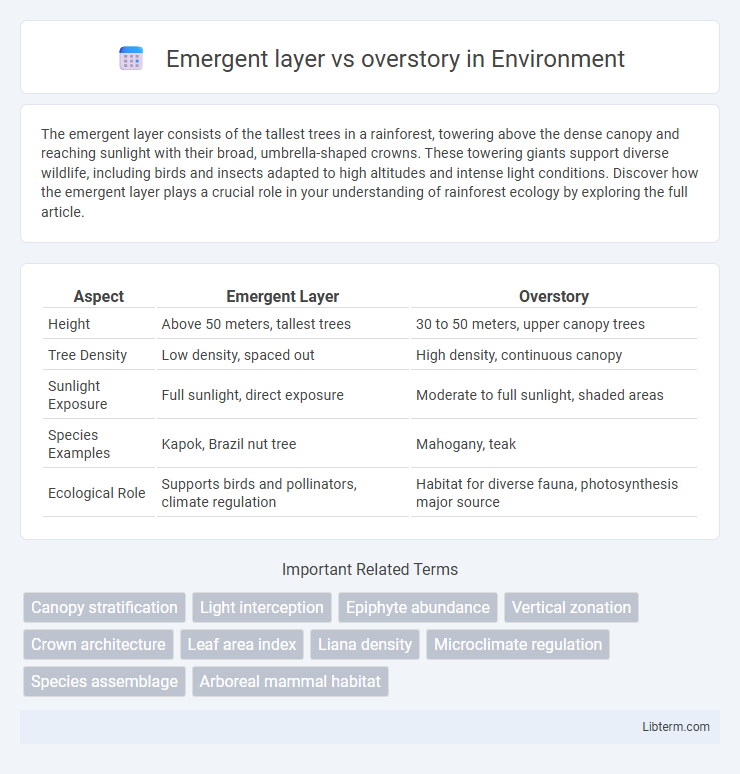The emergent layer consists of the tallest trees in a rainforest, towering above the dense canopy and reaching sunlight with their broad, umbrella-shaped crowns. These towering giants support diverse wildlife, including birds and insects adapted to high altitudes and intense light conditions. Discover how the emergent layer plays a crucial role in your understanding of rainforest ecology by exploring the full article.
Table of Comparison
| Aspect | Emergent Layer | Overstory |
|---|---|---|
| Height | Above 50 meters, tallest trees | 30 to 50 meters, upper canopy trees |
| Tree Density | Low density, spaced out | High density, continuous canopy |
| Sunlight Exposure | Full sunlight, direct exposure | Moderate to full sunlight, shaded areas |
| Species Examples | Kapok, Brazil nut tree | Mahogany, teak |
| Ecological Role | Supports birds and pollinators, climate regulation | Habitat for diverse fauna, photosynthesis major source |
Introduction to Forest Canopy Layers
Emergent layer trees rise above the general canopy, reaching heights of up to 70 meters, and receive the most sunlight, playing a critical role in forest microclimates and biodiversity by housing unique wildlife species. The overstory forms the continuous upper layer of the forest, typically composed of mature trees that create a dense canopy measuring between 20 to 40 meters tall, which regulates light penetration and maintains humidity levels below. Both layers are integral to forest ecosystems, influencing photosynthesis rates, nutrient cycling, and providing distinct habitats within tropical rainforests.
Defining the Emergent Layer
The emergent layer consists of the tallest trees in a rainforest, rising above the continuous canopy or overstory layer. These trees can reach heights of 40 to 70 meters, capturing most sunlight and withstanding strong winds due to their exposed position. Their primary role is to provide critical habitat and contribute to the forest's vertical complexity, distinct from the dense, continuous coverage of the overstory.
Characteristics of the Overstory
The overstory consists of the tallest and most mature trees forming a continuous canopy layer that intercepts a majority of the sunlight, significantly influencing microclimate and light availability below. This layer supports diverse wildlife habitats and plays a critical role in photosynthesis, carbon sequestration, and nutrient cycling within forest ecosystems. Unlike the emergent layer, which features scattered, towering trees protruding above the canopy, the overstory maintains a dense, interconnected crown cover crucial for ecosystem stability.
Key Differences Between Emergent Layer and Overstory
The emergent layer consists of the tallest trees that rise above the continuous canopy, reaching heights often exceeding 70 meters, whereas the overstory mainly comprises the upper canopy trees forming a dense layer below the emergents. Emergent trees receive the most sunlight and face greater exposure to winds and weather, while the overstory provides a more sheltered environment with moderate light penetration. Structurally, emergent trees have thicker trunks and larger crowns adapted for solitary growth, contrasting with the overstory's interconnected crown layers essential for canopy coverage.
Plant Species Found in the Emergent Layer
The emergent layer of tropical rainforests features plant species such as the Brazil nut tree (Bertholletia excelsa), kapok tree (Ceiba pentandra), and towering dipterocarps, which rise above the dense overstory canopy. These species exhibit adaptations like large buttress roots and thick bark to withstand strong winds and intense sunlight at higher elevations. Unlike the overstory layer dominated by a continuous canopy, emergents penetrate the forest ceiling, playing a crucial role in providing habitats for birds and pollinators sensitive to light and wind exposure.
Typical Flora in the Overstory
Typical flora in the overstory includes mature, tall trees such as mahogany, kapok, and ceiba, which form a dense canopy layer approximately 30 to 45 meters high. This layer hosts a diverse range of broad-leaved evergreen species that capture most of the sunlight, supporting various epiphytes, lianas, and fauna. The overstory plays a critical role in forest ecology by regulating microclimate and facilitating nutrient cycling essential for ecosystem health.
Wildlife Adaptations in the Emergent Layer
Wildlife adaptations in the emergent layer of rainforests include specialized physical traits such as elongated limbs and strong wings that enable animals like harpy eagles and certain monkey species to navigate the towering trees and withstand high winds. These adaptations also involve behavioral traits, including heightened vision and vocal communication, which facilitate hunting and mate attraction above the dense canopy. The emergent layer's exposure to intense sunlight and reduced humidity drives further physiological adaptations, such as water retention and UV protection in resident wildlife.
Fauna Commonly Seen in the Overstory
The overstory, comprising mature trees forming a continuous canopy, supports a diverse range of fauna such as monkeys, toucans, and various birds of prey frequently seen perching or nesting among these upper branches. This layer provides essential habitat and foraging sites for arboreal mammals and insects adapted to the dense foliage. In contrast, the emergent layer, with towering trees rising above the canopy, hosts species like harpy eagles and certain bats that thrive in open, sunlit environments above the overstory.
Ecological Importance of Emergent and Overstory Layers
The emergent layer, characterized by towering trees that surpass the canopy height, plays a crucial role in regulating microclimates and providing habitats for specialized wildlife such as raptors and bats. The overstory, forming the continuous upper canopy, supports a diverse array of organisms by facilitating photosynthesis and acting as a key component in nutrient cycling within forest ecosystems. Together, these layers contribute significantly to maintaining forest biodiversity and ecosystem stability by enhancing structural complexity and resource distribution.
Conservation Challenges and Threats to Canopy Layers
Emergent layer trees face heightened risks from deforestation, logging, and climate-induced droughts, which undermine their critical role in forest microclimate regulation and habitat provision. Overstory canopies experience threats such as habitat fragmentation, invasive species, and increased vulnerability to disease, resulting in compromised biodiversity and disrupted ecological processes. Protection strategies must address these challenges by integrating habitat connectivity, controlling invasive species, and promoting sustainable forest management practices.
Emergent layer Infographic

 libterm.com
libterm.com